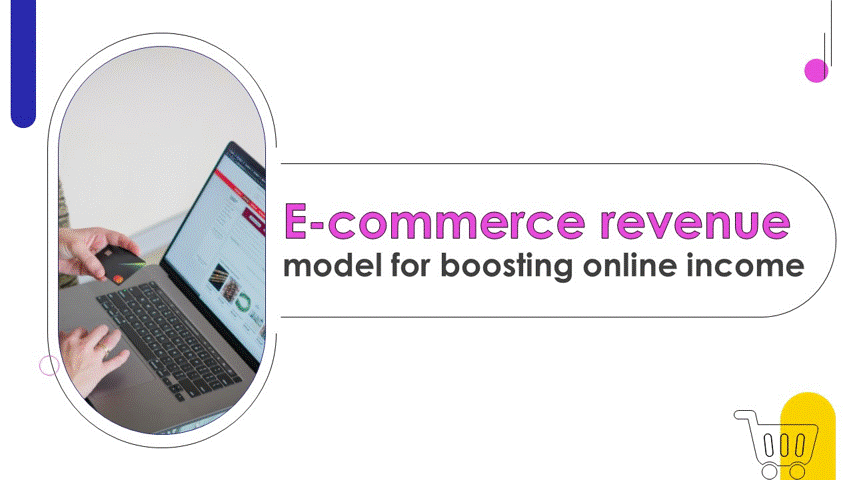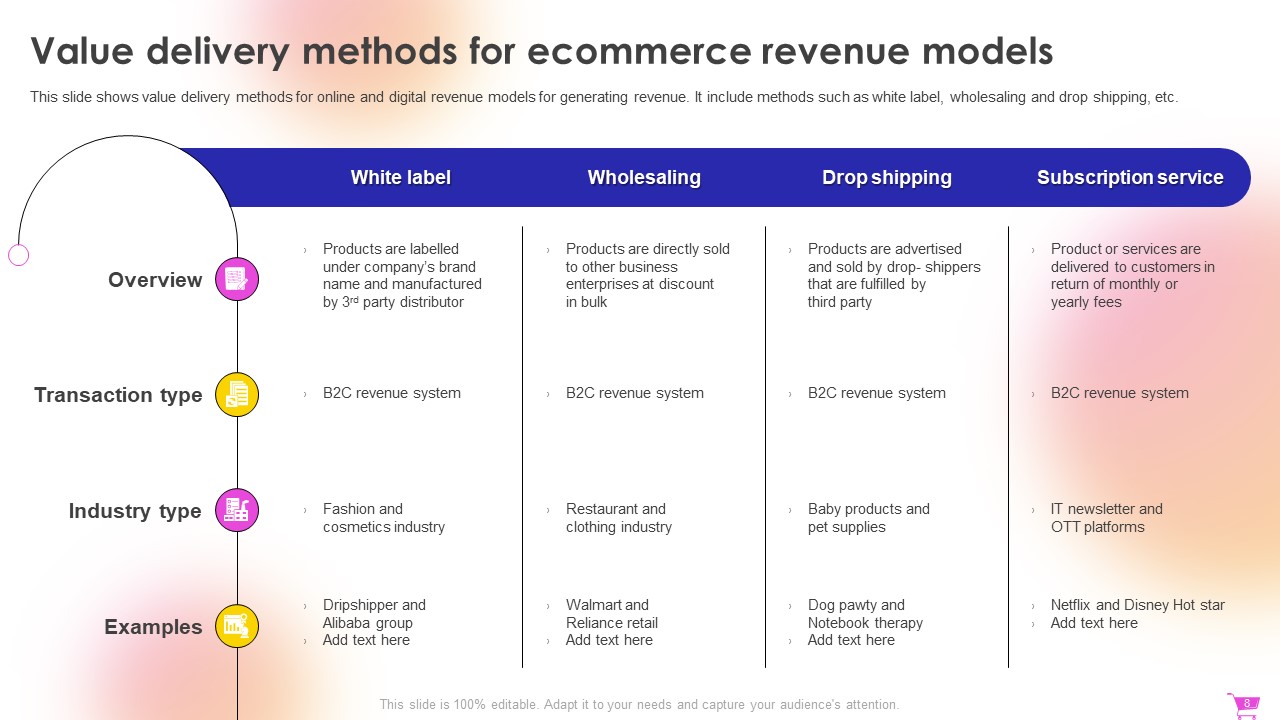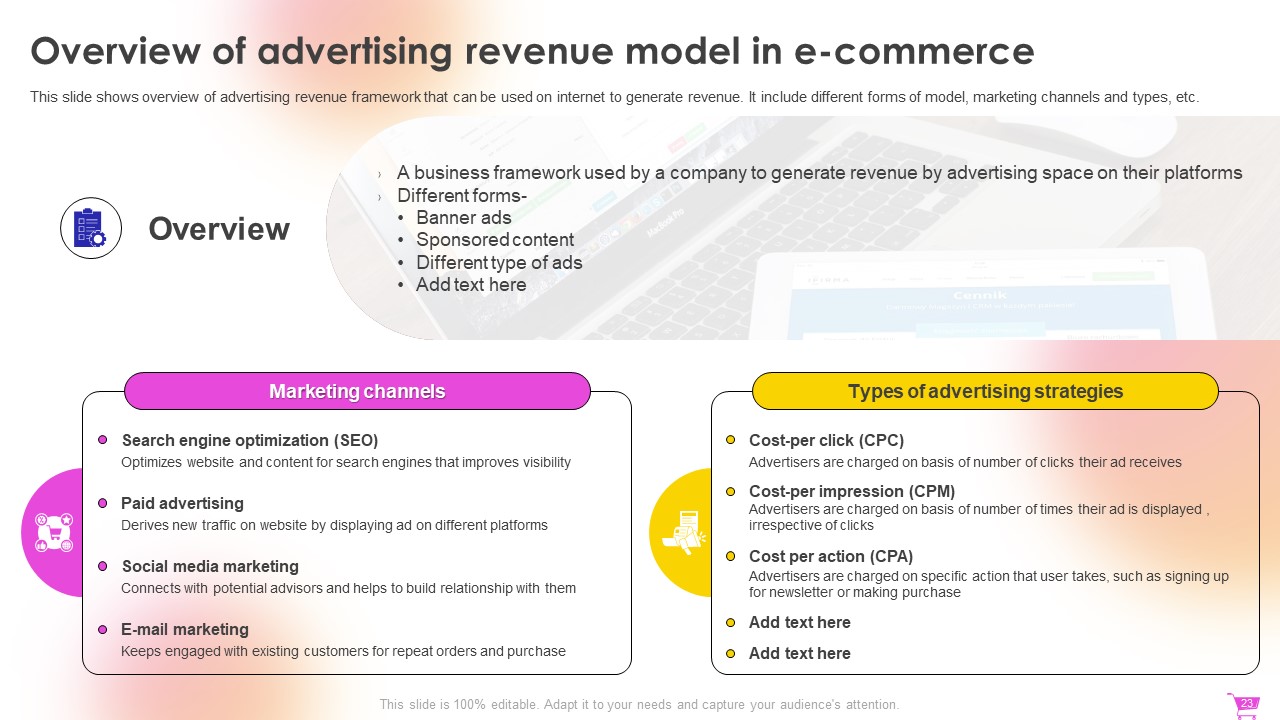“E-Commerce has shown massive changes in the past year, and it is anticipated that by 2025, the market's value of E-Commerce will continue to rise till it reaches $7.385 trillion.”
Every business nowadays is deeply impacted as most offline stores are forced to shift to e-commerce to keep their businesses going.
What is Electronic Commerce?
E-commerce, or electronic commerce, is a type of business that occurs online. And it can be in any form:
- Placing an order for a product
- Selling a product digitally
- Accumulating information from the intended buyers
However, E-commerce can be challenging for a business without its revenue model.
What is the Revenue Model?
A Revenue Model is a framework through which firms strategically plan to generate revenue as much as possible. Also, this model can be of any type, from selling goods to promoting, subscription offers, etc. Moreover, choosing the best Revenue model is crucial as it acts as a roadmap to generate income and attain success.
In this blog, the PowerPoint templates on the E-commerce Revenue Model are designed to be reliable when seeking financial success. With a plethora of insights and features that are easy to use and adjust, they enable you to understand better, plan, and manage your income sources. Therefore, giving you a significant advantage in achieving long-term success.
Additionally, these PowerPoint Slides are fully editable and have flexible features that provide the structure to modify your presentations to suit your particular preferences.
Cover Slide
This is the cover slide displaying the Title of the presentation. Explore different models necessary to build long-lasting connections with clients, taking assistance from this slide. Just add your Company’s Name and start!
Download this PowerPoint Template now.
# Overview and Benefits of E-commerce Revenue Models
The slide briefly introduces E-commerce Revenue Models and the key benefits leading to revenue generation.
Moreover, the advantages of the E-commerce Revenue Model are as follows:
- Saves Time: E-commerce has everything automated, allowing quick transactions and saving buyers valuable time.
- Low Operational Cost: E-commerce results in low operational costs as there is no requirement for physical stores and everything is done digitally.
- 24*7 Available: Buyers can access it anywhere and anytime, as everything is done digitally.
Additionally, this slide also discusses different types of E-commerce Transactions, which are as follows:
- B2B: In B2B transactions, products are sold to other companies through online websites and platforms.
- B2C: In B2C transactions, products and services are sold to customers online.
- C2B: Through C2B, products, and services are sold to companies by online platforms or freelancers.
- C2C: In customer-to-customer transactions, items and services are sold from one buyer to another digitally.
Moreover, it is essential to provide an overview of the benefits of e-commerce models, as through this, firms can effectively explore the ever-changing world of business on the internet and plan their approach successfully.
Download this PowerPoint Template now.
# Types of E-commerce Revenue Business Transactions
The slide highlights different kinds of digital business transactions to earn money. Further, this slide describes distinct types of E-commerce Revenue models according to the estimated report of 2023 and along with their examples, which are as follows:
- B2C: Netflix and Amazon Prime are examples of the Business-to-Consumer model, where companies sell their product digitally.
- B2B: In the business-to-business model, Alibaba and Amazon are examples of products and services sold online.
- B2C: Shutterstock and Upwork are examples of the B2C model, where the businesses from the individuals outsource items and services offered.
- C2C: Through eBay and Esty Inc., things and services are offered online from one person to another.
Also, it is essential to highlight different types of e-commerce revenue models as it provides a brief knowledge and structure for every model. Therefore, this enables us to reach heights in this constantly changing digital market.
Download this PowerPoint Template now.
# Value Delivery Methods for E-commerce Revenue Models
The slide illustrates value delivery methods for digital revenue models to gain financially, which are explained as follows:
- White-label: In this strategy, products are manufactured by third parties and sold to consumers by the brand’s name. And these are mainly beauty and fashionable items.
- Wholesaling: This technique is quite similar to White-Label, but the only difference is items are sold in large quantities to other businesses at discounted prices. Also, the items sold are mainly clothes and are for restaurants.
- Drop Shipping: Baby or pet products are sold through this method, which is a third-party manufacture.
- Subscription Services: Through this method, items and services are sold to those users who pay fees every month or manually.
Moreover, establishing Value Delivery Methods for E-commerce Revenue Models is crucial as it enables continued revenue development in the competitive E-commerce marketplace.
Download this PowerPoint Template now.
# Overview of Advertising Revenue Model in E-commerce
The slide displays a summary of promoting the Revenue Model online that would lead to financial gains. Further, this slide includes manifold Marketing channels, which are as follows:
- SEO (Search Engine Optimization)
- Paid Advertising
- Social media advertising
- E-mail Marketing
Additionally, the slide also demonstrates distinct types of Advertising Techniques: CPC (Cost-per-click), CPA (cost-per-action) and CPM (cost-per-impression).
Moreover, it is essential to provide an overview of the advertising revenue model in e-commerce as it maintains profitability and promotes the expansion of e-commerce businesses in a highly competitive digital marketplace.
Download this PowerPoint Template now.
# Overview of Subscription Fees Revenue Model
The slide briefly describes the subscription financial model annually or monthly. Further, this slide covers Essential components, Revenue calculation criteria and Popular Subscription models, which are explained as follows:
Essential components:
The essential components include product market fit, subscription pricing strategy, exceptional customer services, and subscription revenue tech stack.
Revenue calculation criteria:
Under Revenue calculation criteria, Annual recurring revenue (ARR), Monthly recurring revenue (MRR), and Customer lifetime value (CLV) are included.
Popular Subscription models:
Well-known subscription models are Saas platforms, subscription boxes, Publications and newsletters, and video and music streaming videos.
Download this PowerPoint Template now.
# Overview of Transaction Fee Revenue Model
The slide summarizes the transaction fee Revenue model to get financial gains.
What is the Transaction Fee Revenue Model?
A transaction-based revenue model is a business strategy in which a company sets up a system for processing payments individually for buying goods and services.
Additionally, this slide covers various strategies for expanding the revenue, which are as follows:
- Offering extra value to customers
- Good customer services
- Create loyalty programs
Further, the advantages of transaction fee revenue model are also covered on this slide:
- Increases the profit margin of the organization
- More control over the pricing of products and services
- Ensures freedom of choice to customers on an individual basis
- Better and more detailed insights into a customer journey for retaining customers
- Better negotiation opportunities
However, the Transaction Fee Revenue Model is essential because it creates a steady flow of revenue by charging for each transaction made possible by the platform. Also, this framework gives companies a successful and flexible way to make money while providing a helpful intermediary service.
Download this PowerPoint Template now.
# Overview of Indirect Sales Revenue Model
The slide gives an insight into the indirect sales revenue model to get monetary gains digitally.
What is the Sales Revenue Model?
The sales revenue model is a platform where shopkeepers, wholesalers, or retailers sell their products online to reach a larger intended audience and increase profits.
Further, the slide displays the practical techniques of the indirect sales revenue model, which are discussed below:
- Products and services are sold to customers on a commission basis by affiliates.
- Companies rely on third-party companies to advertise products and services
- Companies collaborate with independent agents for marketing campaigns
- The Company promotes solutions to customers under this strategy
Moreover, this slide displays the advantages of the indirect sales revenue model that are:
- Revenue model can be easily scaled according to market conditions and demand
- This model cut down the cost of hiring and training in the organization
- This Revenue Model ensures proper focus on product development and designing
- Lastly, it lowers the risk of launching a new product in the market
Also, it is essential to have the Indirect Sales Revenue Model, as with this framework, companies may focus on their core strengths and rely on strategic partners to handle sales and distribution. Therefore, this would increase market share and efficiency in operations and support joint expansion.
Download this PowerPoint Template now.
# Overview of Affiliate-based Revenue Model
The slide briefly overviews the Affiliate-based Revenue Model via the Internet to earn income.
What is an Affiliate Revenue Model?
An affiliate model is a framework where affiliate websites get paid to send traffic of potential customers to an online merchant store.
Also, the slide demonstrates different Marketing channels and types of models.
Additionally, Marketing channels include:
- Search Affiliates- Advertisement of product takes place with the help of collaboration with a suitable partner
- Coupon sites- Products are promoted by providing coupons and discounts to long-term users
- Review Sites- Promotion of products is done with the help of collaboration with field experts
- Influencers- Products and services are promoted in the market by collaborating with social media influencers.
Further, Types of Models include:
- Pay Per Click (PPC)- The Advertiser is charged for every click the user visits.
- Pay Per Sales (PPS)- The Advertiser is charged for every successful purchase made through an affiliate link.
- Pay Per Lead (PPL)- The Advertiser is charged as the user fills out the form and registers as a lead.
- Pay Per Impression (PPI)- The Advertiser is charged for successful user landing on the merchant’s website.
Moreover, providing an affiliate-based revenue model is essential because it allows businesses to grow their audience effectively and increase sales without paying for upfront advertising.
Download this PowerPoint Template now.
# Allocating Budget for Implementing E-commerce Revenue Model
The slide displays the budget distribution to employ e-commerce in business and generate a greater return on investment.
Moreover, the slide includes the areas in which budget allocation should be done, such as business operations, customer handling, customer experience, and research and innovation.
Also, it is essential to allocate a budget for implementing the E-commerce Revenue model as properly distributing funds would lead to optimum utilization of funds, further satisfying the users.
Download this PowerPoint Template now.
Conclusion
There's a great chance to participate actively in today's heated competition, and this blog covers a wide range of revenue models in detail. And the only thing necessary is understanding your clients and their needs, assessing your current assets for a workable revenue model, and determining how to spend your budget wisely.
Further, utilize these editable e-commerce company templates as a structured approach to gain more profits. Additionally, these strategies would enable companies to influence customer purchasing experience. Therefore, use these templates for a positive and sustainable relationship between businesses and their customers.
To get a custom deck designed for your business needs, contact our experts at www.slideteam.net.
Click here to get a Free E Commerce Revenue Model PPT. & E-Commerce Revenue Model PDF.
FAQs on E-commerce Revenue Model
Is the E-commerce Revenue Model susceptible to market fluctuations?
Yes, E-commerce Revenue Models can be influenced by market fluctuations, changes in consumer behavior, technological advancements, and competitive shifts. Also, businesses need to adapt and evolve their revenue strategies accordingly.
Where can I find more resources to understand and implement E-commerce Revenue Models?
Firstly, Numerous online resources, industry reports, business articles, and specialized courses on E-commerce offer in-depth insights into various revenue models and their implementation strategies. Additionally, consulting with experts in the field can provide valuable guidance.





 Customer Reviews
Customer Reviews






























